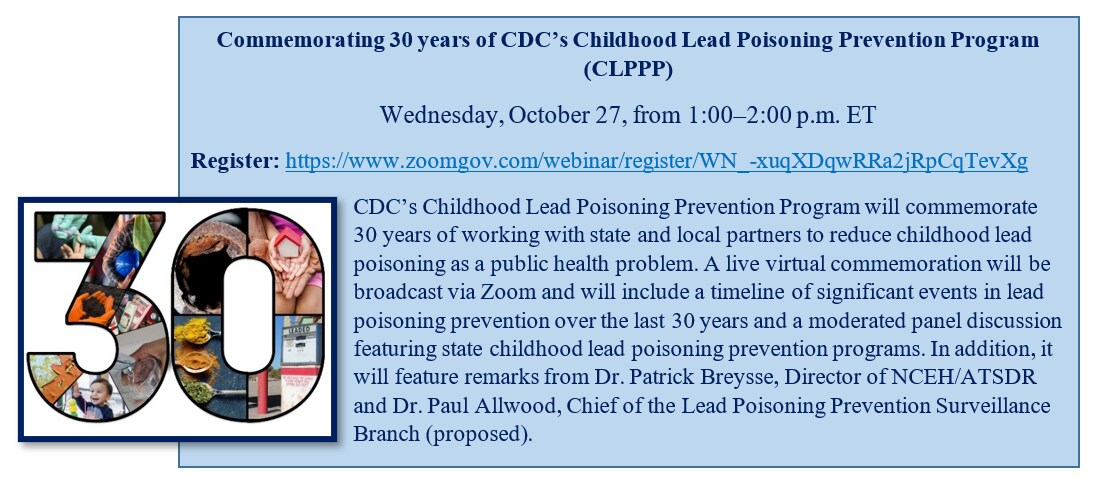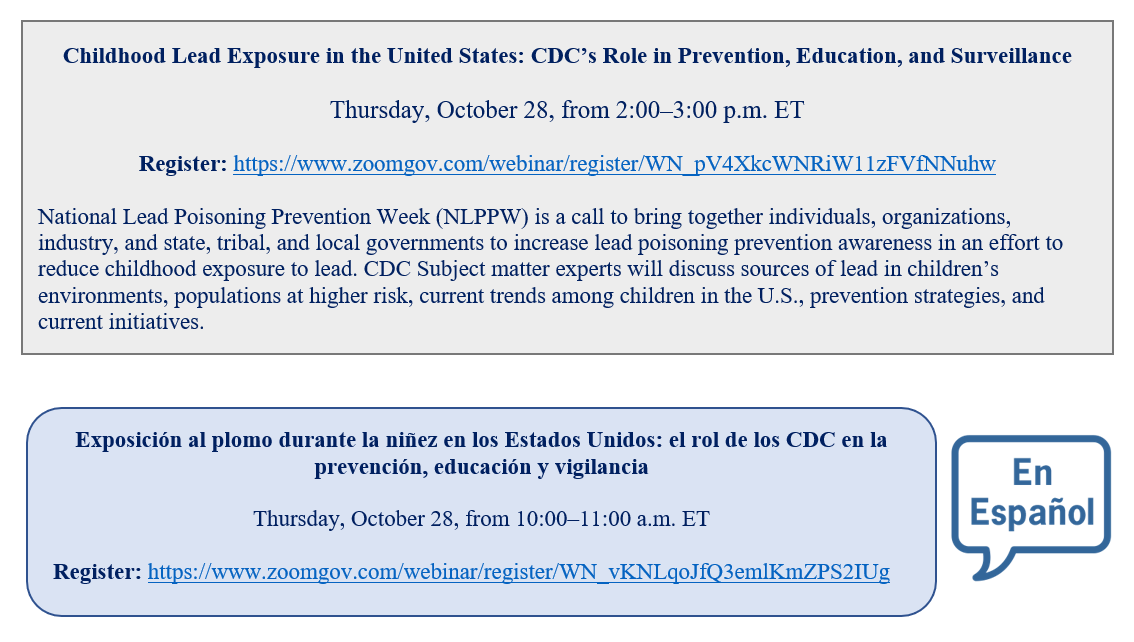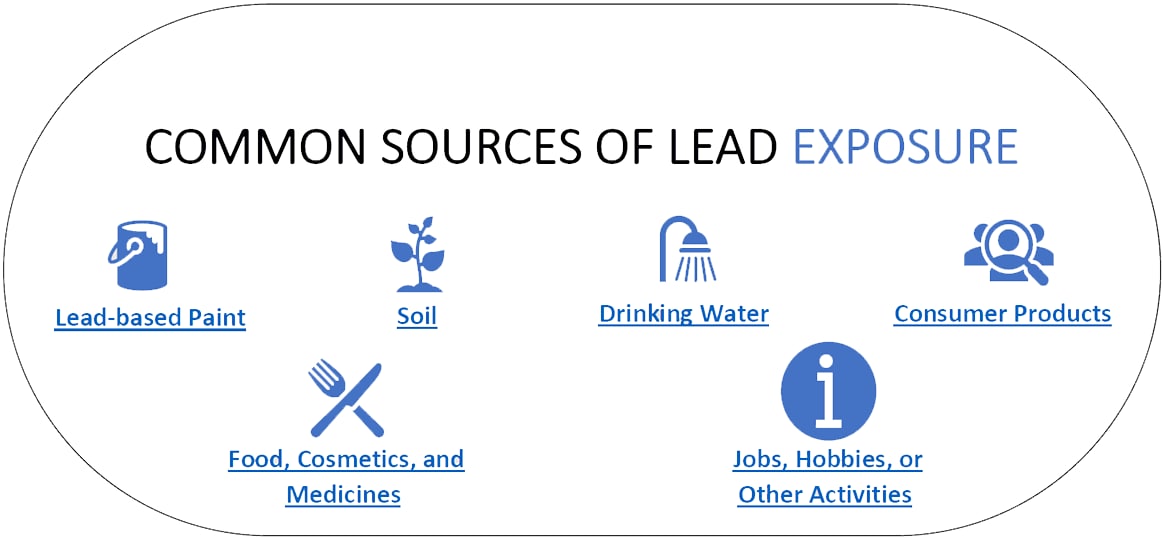CDC Environmental Health Nexus Newsletter
Healthy Environment, Healthy You
October 20, 2021 | Volume 6

Environmental News Nexus
CDC’s Environmental Health Nexus (EH Nexus) shares environmental health messages with the public and gives special attention to environmental justice.
EH Nexus newsletters provide info about environmental health issues and offers information that promotes actions to help save lives. Each newsletter will communicate how to reduce harm from many threats, including climate change, contaminated food and water, toxic environments, and inadequate systems and practices.
This issue covers the following topics:
- National Lead Poisoning Prevention Week
- National Lead Poisoning Prevention Week Webinars: Making an Impact
- Lead and Your Health
- Common Sources of Lead Exposure
- Learn About Lead, a Serious Problem for Children
- Lead Poisoning in Children is Preventable
- Environmental Health Resources and Updates
If the newsletter was emailed to you, we thank you for joining our subscription distribution list. If you are not a subscriber, please click here, enter your email address, and click the subscribe button.
National Lead Poisoning Prevention Week
National Lead Poisoning Prevention Week (NLPPW) is October 24–30, 2021. It’s a time to reflect on the severe issue of lead poisoning in our country.
Each year, NLPPW is a call to bring together individuals, organizations, industry, and state, tribal, and local governments to increase lead poisoning prevention awareness in the effort to reduce childhood exposure to lead. NLPPW highlights the many ways parents can reduce children’s exposure to lead in their environment and prevent its serious health effects.
The U.S. Department of Housing and Urban Development (HUD), the U.S. Environmental Protection Agency (EPA), the Centers for Disease Control and Prevention (CDC), and our partners work to heighten awareness of lead poisoning, provide resources, and encourage preventive actions during NLPPW and beyond.
NLPPW Webinars: Making An Impact!


Lead and Your Health

Lead-based paint and lead-contaminated dust, soil, and water are the primary sources of lead exposure for U.S. children. Lead-based paints were banned for use in housing after 1978. All houses built before 1978 are likely to contain some lead-based paint. However, it is the deterioration of this paint that causes a problem.
Approximately 22.3 million housing units have deteriorated leaded paint and elevated levels of lead-contaminated house dust. An estimated 2.6 million homes with children younger than 6 years of age have one or more lead-based paint hazards.
The health effects are the same if a person breathes, swallows, or absorbs lead particles. However, the body absorbs higher levels of lead when it is breathed in. Once our body absorbs lead, it is stored in our bones, blood, and tissues. It can take decades for lead stored in the bones to decrease.
Lead Exposure: An Environmental Justice Concern
Economic, social, and cultural factors continue impacting health outcomes and the exposure of some to environmental hazards more than others. Environmental justice (EJ) is an effort to address environmental health disparities. EJ will be achieved when everyone enjoys the same degree of protection from environmental and health hazards, and equal access to the decision-making process to have a healthy environment.
All people—regardless of race, color, national origin, or income—are entitled to equal protection from environmental and health hazards and equal access to the development, implementation, and enforcement of environmental laws, regulations, and policies.
Lead exposure is a matter of environmental justice. Some African American persons are at a higher risk of lead exposure due to poor housing stock. Children from low-income households and those who live in housing built before 1978 are at the greatest risk of lead exposure because these homes are more likely to contain lead-based paint and have pipes, faucets, and plumbing fixtures containing lead.
CDC’s Environmental Public Health Tracking Network has an environmental justice dashboard to help determine communities at risk, help make informed policy decisions, and help everyone learn more about how the environment affects their health.

Common sources of lead exposure. Lead-based paint. Soil. Drinking water. Consumer products. Food, Cosmetics, and Medicines. Jobs, Hobbies, or Other Activities.
Learn About Lead, A Serious Problem for Children
Children are particularly vulnerable to even small amounts of lead exposure because their bodies are still developing and growing rapidly. Lead exposure can cause detrimental health effects and long-term harm.
Children can breathe in lead dust or eat lead from soil, dust, or paint chips when they put their fingers in their mouths. Younger children also tend to put their hands or other objects, which may be contaminated with lead dust, into their mouths, so they are more likely to be exposed to lead than older children. Children living at or below the poverty line and those who live in older housing are at greatest risk. Children of some racial and ethnic groups are disproportionately affected by lead because they may not have access to safe, affordable housing or face discrimination when trying to find a safe, healthy place to live.
Additionally, lead can pass from a mother to her unborn baby. Thus, children born to lead-exposed mothers are at a greater risk for lead exposure.
Other countries have less strict regulations to protect children from lead exposure; therefore, children who are immigrants, refugees, or recently adopted from outside of the United States are also at risk for higher lead exposure.
Lead is quickly absorbed into the blood stream. Once a child ingests lead, their blood lead level rises. Once a child’s exposure to lead stops, the amount of lead in the blood decreases gradually. The child’s body releases some of the lead through urine, sweat, and feces.
Many things affect how a child’s body handles exposure to lead, including
- Child’s age
- Nutritional status
- Sources of lead exposure
- Length of time the child was exposed
- Presence of other underlying health conditions

Protecting children from exposure to lead is important for lifelong good health. No safe blood lead level in children has been identified. Even low levels of lead in blood have been shown to affect learning, ability to pay attention, and academic achievement.
The most important step that parents and caregivers, healthcare providers, and public health professionals can take is to prevent lead exposure before it occurs.
While some effects of lead poisoning may be permanent, if caught early there are things parents can do pdf icon[PDF – 234 KB] to prevent further exposure and reduce damage to their child’s health.
American Journal of Public Health (AJPH) Call for Papers
The American Journal of Public Health (AJPH), in collaboration with the Centers for Disease Control and Prevention (CDC), intends to publish a supplemental issue on the topic of lead hazards, prevention-mitigation programs, and emerging sources of exposure. The supplement will address and contribute to the comprehensive understanding of currently known and emerging hazardous sources of lead exposure related to global trade, climate change, and infrastructure renewal.
Manuscripts must be submitted to AJPHexternal icon by January 30, 2022. For more information about this supplement, visit the Call for Papers web page.
Thank you for reading. Do not keep this great resource to yourself! Please share it with your colleagues and networks.
If you are not yet a subscriber, please click here, enter your email address, and click the subscribe button at the bottom of the webpage.

